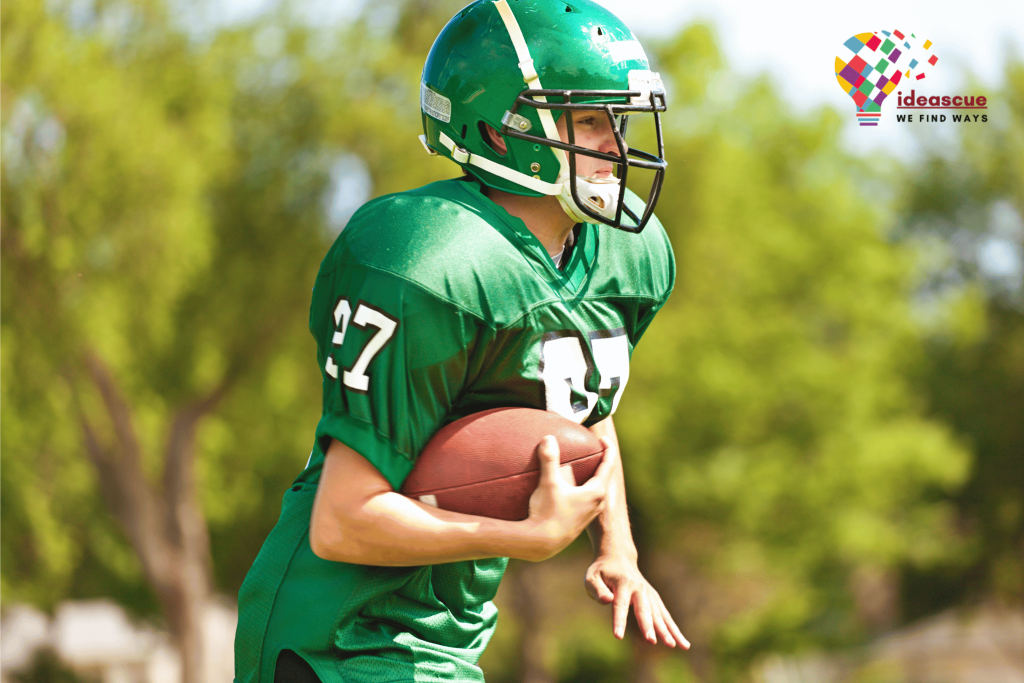Football Strength and Conditioning Program: Benefits Objectives And More!
Introduction
American football, a sport revered for its intensity and physicality, necessitates a specialized training approach. Unlike traditional fitness routines, players require a regimen tailored to the unique demands of the game. This article demystifies the essentials of a football strength and conditioning program, explaining how it differs from bodybuilding, its benefits, and practical workout plans for aspiring athletes.
Bodybuilding primarily targets muscle growth and visual appeal, whereas football training emphasizes practical strength, quickness, and agility.
In football explosive workouts and explosive leg lifts enhance lower body power for on-field agility and acceleration., quick directional changes, and enduring the physical demands of the game. This requires a blend of strength training, plyometrics, and cardiovascular conditioning, unlike the isolated muscle focus in bodybuilding.
What is a Football Strength and Conditioning Program?
A football strength and conditioning program outlines a comprehensive fitness strategy. It’s made for football players. The plan includes strength and conditioning workouts for football. These workouts are diverse.
They enhance overall sports performance. The program involves more than mere weightlifting. It combines various exercises. These include speed work and agility drills. It also has endurance training. Plus, it has specific exercises. These exercises boost an athlete’s effectiveness during gameplay.
Objectives for Strength and Conditioning Routines in Football
Stability:
Stability exercises are vital for football athletes. It helps maintain balance, control movements, and prevent injuries. This involves exercises that strengthen core muscles and improve overall body coordination.
Strength:
In college or professional football training, developing strength means building muscle power to tackle, block, and withstand the game’s physical demands. This involves weightlifting and resistance exercises focusing on major muscle groups. Consistent training enhances a player’s ability to perform stronger on the field.
Speed:
Speed is a crucial skill in football, enabling players to outrun opponents and react quickly on the field. Effective speed training involves drills like sprints and agility exercises, which enhance a player’s ability to accelerate and change direction rapidly. This skill is integral for both offensive breakthroughs and defensive maneuvers.
Conditioning:
Conditioning in football is about building the stamina and resilience needed to perform at your best throughout the game.
It includes exercises like sprinting, agility drills, and endurance training to keep players sharp and ready for action. This part of the program ensures players can sustain their energy and speed from kickoff to the final whistle.
In football, achieving a linebacker physique level is essential. Whether you aspire to have the agility of a running back or aim to be built like a linebacker, this comprehensive workout plan can help you develop the strength, speed, and endurance required for peak performance on the field.

Benefits of Football Strength and Conditioning Program:
Improves Speed:
Speed is a critical aspect of football, and a well-designed strength and conditioning program directly contributes to faster sprints and quicker movements on the field. By incorporating exercises like plyometrics and interval sprints, players develop the explosive power needed for rapid acceleration.
In addition to building muscle strength, these workouts enhance the neuromuscular coordination necessary for speed.
Grip Strength:
Grip strength is crucial in football, especially for players handling the ball. Strong hands aid in catching, holding, and managing the ball in high-pressure situations. Players with solid grip strength are less likely to fumble and can better withstand tackles and impacts.
Increases Power:
Power is essential in football, allowing players to tackle, sprint, and jump effectively. Exercises like Olympic lifts and plyometrics specifically target this aspect, enhancing a player’s explosive strength.
Enhances Agility:
Agility is vital in football for quick movements and direction changes. A football strength and conditioning program includes drills that improve this skill. These drills help players dodge opponents and change direction swiftly.
Builds Endurance:
Endurance is crucial in football for maintaining peak performance throughout the game. A strength and conditioning program helps players increase their stamina, enabling them to execute plays effectively from start to finish.
Core Stability
Core stability is pivotal for football athletes to sustain stability and manage movements dynamically. A strong core helps in effectively transferring power from the lower to the football upper body workout, crucial for tackling, throwing, and sprinting. It also plays a key role in preventing injuries by supporting the spine and pelvis during intense physical activities.
Explosive Power:

Explosive power is crucial in football for fast, dynamic movements like jumping, sprinting, and quick changes in direction. This aspect of fitness enables players to unleash maximum force in the shortest time possible, giving them an edge on the field.
Football Strength Program – Footballer Weekly Schedule:
Although this may not sound like a perfect NFL workout routine, it is sufficient to keep you towards a professional track.
| Day | Exercise 1 | Sets/Reps | Exercise 2 | Sets/Reps | Exercise 3 | Sets/Reps | Exercise 4 | Sets/Reps | Exercise 5 | Sets/Reps |
| Monday | Squats | 4×8 | Bench Press | 3×10 | Deadlifts | 3×8 | Pull-Ups | 3×10 | Lunges | 3×10 |
| Tuesday | Sled Pushes/Pulls | 4×10 | Box Jumps | 3×12 | Rows | 3×10 | Farmer’s Walks | 3×5 min | Calf Raises | 3×15 |
| Wednesday | Rest/Recovery | – | – | – | – | – | – | – | – | – |
| Thursday | Overhead Press | 3×10 | Squats | 4×8 | Deadlifts | 3×8 | Lunges | 3×10 | Pull-Ups | 3×10 |
| Friday | Bench Press | 3×10 | Rows | 3×10 | Box Jumps | 3×12 | Sled Pushes/Pulls | 4×10 | Farmer’s Walks | 3×5 min |
| Saturday | Active Recovery | – | – | – | – | – | – | – | – | – |

Football Conditioning Program:
| Day | Exercise 1 | Sets/Reps | Exercise 2 | Sets/Reps | Exercise 3 | Sets/Reps | Exercise 4 | Sets/Reps | Exercise 5 | Sets/Reps |
| Monday | Interval Sprints | 10x100m | Agility Ladder Drills | 5x | Hill Sprints | 6x50m | Shuttle Runs | 6x20m | Jump Rope | 10 min |
| Tuesday | Plyometric Drills | 4×10 | Cone Drills | 4x | Treadmill Running | 20 min | Stationary Bike | 30 min | Stretching | 10 min |
| Wednesday | Rest/Recovery | – | – | – | – | – | – | – | – | – |
| Thursday | Shuttle Runs | 6x20m | Jump Rope | 10 min | Hill Sprints | 6x50m | Agility Ladder Drills | 5x | Plyometric Drills | 4×10 |
| Friday | Cone Drills | 4x | Interval Sprints | 10x100m | Treadmill Running | 20 min | Stationary Bike | 30 min | Stretching | 10 min |
| Saturday | Active Recovery | – | – | – | – | – | – | – | – | – |

Strength Training Exercises for Footballers
Squats:
Squats are a foundational exercise in any football strength program. They primarily target the quadriceps, hamstrings, and glutes, crucial for powerful lower body strength. When performing squats, maintaining proper form is key to maximizing benefits and minimizing injury risk. This exercise not only improves leg strength but also enhances core stability, vital for football players in both offensive and defensive situations.
Deadlifts:
Deadlifts are essential for developing overall body strength. This exercise engages the back, glutes, hamstrings, and core, providing a thorough exercise regimen.
Deadlifts are especially beneficial for football players as they mimic the lifting and tackling motions common in the game.
Lunges:
Lunges are highly effective for enhancing leg and core stability. they focus on the quadriceps, hamstrings, and gluteal muscles, while also engaging the core muscles. Lunges help in improving balance and coordination, which are critical for football players who need to perform complex movements during the game.
Additionally, lunges can aid in injury prevention by strengthening the leg muscles and improving flexibility.
Bench Press:
The bench press is a fundamental workout for enhancing upper body strength, focusing on the chest, shoulders, and triceps. For football players, a strong upper body is necessary for blocking, pushing, and physical confrontations on the field.
Regular bench press workouts can lead to significant improvements in upper body power, a crucial element for football athletes.
Pull-Ups:
Pull-ups are effective for strengthening the back and arm muscles. They particularly work the latissimus dorsi, biceps, and forearms. For football players, strong back and arm muscles are essential for grappling with opponents and controlling the ball.
Rows:
Rows focus on strengthening the back and shoulder muscles. They are important for football players as they help in building a strong upper body, essential for effective blocking and tackling.
Rows also improve posture and shoulder stability, which are beneficial for throwing and catching in football.
Overhead Press:
The overhead press focuses on the shoulders and arms, crucial for throwing strength and shoulder stability. This exercise is particularly beneficial for quarterbacks and receivers in football, as it enhances the ability to throw and catch the ball with power and precision.
Olympic Lifts:
Olympic lifts, such as the clean and jerk and snatch, are excellent for developing explosive power and speed.
These lifts engage multiple muscle groups and are highly beneficial for football players, who require explosive strength for tackling, jumping, and sprinting. Olympic lifts also improve coordination and athletic performance.
Farmer’s Walks:
Farmer’s walks excel in enhancing grip strength and overall stamina. This exercise involves carrying heavy weights over a certain distance, engaging the arms, shoulders, back, and core.
For football players, strong grip and endurance are essential for controlling the ball and maintaining strength throughout the game.
Sled Pushes/Pulls:
Sled pushes and pulls are fantastic for building strength and cardiovascular endurance. This exercise mimics the pushing and pulling movements in football, making it highly relevant for the sport.
Calf Raises:
Calf raises are focused exercises for strengthening the lower legs, particularly the calf muscles. Strong calves are important for football players as they contribute to running speed and jumping ability.
Box Jumps:
Box jumps, as a plyometric workout, are intended to boost explosive leg strength. They are crucial for football players who need for quick jumping, sprinting, and direction shifts.
FAQs
Conclusion:
A football strength and conditioning program is more than just lifting weights. It’s a comprehensive approach to building the athleticism required for American football.
By focusing on specific goals such as stability, strength, speed, and conditioning, and following a well-structured workout plan, athletes can enhance their performance on the field.
Keep in mind, that regularity and correct technique are crucial for success in this rigorous yet rewarding training regimen.






